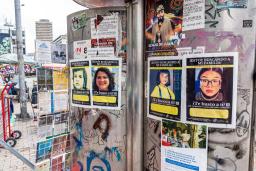Children have always been impacted by armed conflict and it is not improving. According to Save the Children, in 2022, there were approximately 452 million children – or one in six of all children on the planet – that were living in conflict‐affected areas. As of 2024, we are witnessing unprecedented levels of attacks against children in armed conflict contexts. Simon Tisdall’s February 2024 op‐ed in The Guardian[1] sums it up well: “The world is waging war on its children, in an obscene mockery of international law.”
The Impact of War on Children Worldwide
Our responsibility to protect and listen
By Shelly Whitman Ph. D.
Published: May 10, 2024
Tags:

Photo by Rahul Jha on Unsplash
Story text
There is a poignancy to the celebration of Mother’s Day; a day whose creation is attributed to Anna Jarvis when she sent 500 white carnations to a church in her hometown in memory of her mother, Ann Jarvis.
Anna’s inspiration drew from her mother’s wish that there would emerge a day commemorating mothers for the “matchless service she renders to humanity in every field of life.”[2] It was through the proclamation signed by then United States President Woodrow Wilson that Mother’s Day as we know it in North America came into being.
Ann Jarvis bore 13 children of which only 4 survived to adulthood – a common, albeit tragic reality of life in the early 19th and 20th centuries in the Appalachian region[3] of the United States where she called home. That the joy that children bring to mothers is without compare, so too is the immeasurable grief that comes with the loss of one’s child, be it to disease, acts of fate, or as we see too commonly around us, conflict and war.
International child protection efforts
International humanitarian law and the laws of war have distinguished between civilians and combatants for over 150 years. For over a century, normative law assumed that children, defined as anyone under 18, were civilians; however, since the late 1980s, international law specifically recognized and sought to protect a child’s vulnerability in both war and peace. Examples of these key international legal instruments include: the Convention on the Rights of the Child (1989), the African Charter on the Rights and Welfare of the Child (1990), the Worst Forms of Child Labour Convention 182 (2000), and the Optional Protocol to the Convention on the Rights of the Child and the Involvement of Children in Armed Conflict (2002). It should also be noted that the Rome Statute of the International Criminal Court also includes the prohibition of conscription and enlisting of children under its definition of war crimes.
In 1996, the United Nations (UN) created the Children and Armed Conflict mandate to strengthen the protection of children in situations of armed conflict and recommended the appointment of a Special Representative to the Secretary‐General (SRSG) to lead the UN’s advocacy efforts on preventing grave violations against children and their rights in armed conflict (A/RES/51/77).
The first resolution on children and armed conflict in 1999 identified six grave violations that affect children the most in times of war and these include:
- killing and maiming of children;
- recruitment or use of children in armed forces or armed groups;
- attacks on schools or hospitals;
- rape or other grave sexual violence against children;
- abduction of children; and
- denial of humanitarian assistance for children. (UNICEF 2022)
Each year, the UN Secretary‐General releases an Annual Report on Children and Armed Conflict that compiles the data gathered by the UN Monitoring and Reporting Mechanism[4] on these grave violations. Within this report, states and non‐state actors who violate one of the six grave violations against children are listed for these violations and can be subjected to sanctions by the UN Security Council.
As a result of the efforts by the Office of the UN SRSG for Children and Armed Conflict, UN member states and non‐governmental agencies have lobbied to complement UN Security Council Resolution (UNSCR) 1612 with further amplification of efforts to address the six grave violations. Two examples are the Safe Schools Declaration (2015) and the Vancouver Principles on Peacekeeping and the Prevention of the Recruitment and Use of Child Soldiers (2017).
The impacts of armed conflict on children are multi‐pronged and have long‐term consequences beyond the duration of the armed conflict. When children are exposed to armed conflict, denied humanitarian access, displaced from their homes and families and unable to attain education, the ramifications impact the individual child and, at the same time, impact the development of communities and economic growth while perpetuating cycles of insecurity and violence.

“Untitled” by Bîstyek, a Winnipeg‐based Kurdish artist from Syria who fled that country at 16 years of age.
Painting by BîstyekThe unique vulnerability of children in armed conflict
There is an urgent need to advance our understanding of the fragile contexts that threaten children, increase their vulnerability to extreme violence and insecurity, and diminish their agency to positively impact global peace and security. As a direct consequence of armed conflict, children are subjected to forced displacement, food insecurity, lack of access to quality education and healthcare, high unemployment rates and direct violence that cause long‐term physical and psychological harm and effectively deny childhood. The case studies highlighted below illustrate current examples of such unique impacts on children in armed conflicts.
Gaza – children in the crossfire, lack of access to education and healthcare
In June 2023, the UN Secretary‐General expressed deep concerns about the number of children killed and maimed by Israeli forces during hostilities. The use of live ammunition during law enforcement operations, where children are often present, has always been deeply concerning. This points to longstanding concerns regarding violations of the rights of children in Gaza. The Israeli military response following the October 7th Hamas attacks – which resulted in the killing of 1,200 Israelis[5], including 38 children, and the abduction of 42 other children from Israel into the Gaza Strip[6] – has only exacerbated an already grave situation. As James Elder from UNICEF stated two months into the current war, “In my twenty years with UNICEF, traveling from one humanitarian crisis to the next – from famines to floods and war zones to refugee camps – I’ve simply never seen such devastation and despair as is happening in Gaza.”[7]
Children in Gaza have faced much of the brunt of the Israel‐Hamas conflict.
Photo: Reuters, photograph by Yasser QudihAll parties to this conflict must uphold their obligations under international humanitarian law to ensure that civilians, including children, are not targeted during hostilities and that all necessary precautions are taken to protect them. In early April 2024, Save the Children reported that some 26,000 children – over 2% of Gaza’s total child population – have been killed or injured since an attack on Israel on October 7th and the assault on Gaza that has followed.[8] As a direct consequence of the war, many children have been orphaned and are now living alone and fending for themselves and others,[9] and UNICEF reports that at least 53 of Gaza’s 563 school buildings have been destroyed. Nearly 90% of schools have been damaged.[10]
Sudan – forced displacement, lack of education and food insecurity
The most current war in Sudan began April 15, 2023. The widespread malnutrition, the world’s largest child displacement crisis and a shattered health system threaten to kill far more children than the armed conflict itself. The numbers speak for themselves. According to an April 2024 statement put out by UNICEF,[11] a staggering half of Sudan’s population, some 25 million people, now require life‐saving humanitarian assistance. This figure includes a heartbreaking 8.6 million people displaced from their homes, both internally and across borders, with four million of them being children. The ongoing violence has also claimed a devastating human cost, with over 14,000 innocent lives lost. Thousands have been killed and injured, and countless more are exposed to grave protection violations, including sexual violence and recruitment into conflict.
Two young South Sudanese child soldiers.
Photo: © UNICEF / RichWith most schools shuttered or struggling to reopen across the country, a staggering 19 million school‐age children risk losing out on their education in violation of the Convention for the Rights of the Child and the International Covenant on Economic Social and Cultural rights, as well as every state constitution. James Elder, UNICEF Spokesperson, reported, “The world’s largest displacement of children has been seen in Sudan. Four million children have been displaced. That’s 13,000 children every single day for 300 days.”[12] This is unprecedented and too often, in the competing landscape of tragedies, overlooked in the international agenda.
Colombia – armed violence, recruitment of children and trafficking
After over a half century of war, the existence of the Total Peace Initiative by the Government of Colombia is a positive development. Despite this, conflict and displacement persist, with 7.7 million children needing humanitarian aid and, of those, 3.1 million in acute need. Displacement of all people rose 50% since 2021, affecting 7.2 million in rural regions, with a particular impact on children.[13]
In 2023, Colombia struggled to protect children and adolescents from violence and exploitation. Child recruitment into armed groups, particularly from areas with large Indigenous populations, remained high. The UN verified 208 cases (35% girls, 65% boys) from January to September 2023, up from 130 cases in 2022. Indigenous children constituted nearly half (48%) of these cases, with the Cauca Department recording the highest rate (38%). Colombia is in a unique geographical location, plagued by the history of armed conflict, migration flows because of armed violence in neighbouring states such as economically devastated Venezuela, and the impact of the global drug trade and human trafficking rings. As a result, children continue to be impacted not only by armed conflict but also by extra‐judicial armed violence.

“I am looking for my family” – posters of youth displaced from their family in Bogota, Colombia.
Photo: Getty Images, photograph by Jeff GreenbergOne of the ongoing and most devastating effects of the continued armed conflict is the strategic targeting of children for trafficking and militias and the impact it has on their families. Civil society has responded – naming this practice of “disappearing” someone or “desapareciendo” as a specific human rights violation.
Engaging children in their future
Children have a fundamental right to participate in decision‐making processes that concern their wellbeing. Too often, children under the age of 18 are not seen as stakeholders in the global peace and security efforts. Preventing children’s involvement in – and exposure to – armed conflict, coupled with concerted efforts to work directly with children and youth to build and sustain peace, is necessary to break intergenerational cycles of armed violence.
We need to reframe the way we think about and understand children’s participation and protection. Understanding and including children’s perspectives in peace and security can contribute to the empowerment of children as agents of change, bring diverse solutions to intractable problems, and help us to disrupt long‐term consequences of armed conflict that impact children’s identity, belonging and connection to family and communities. The challenge of supporting children’s engagement is not about their lack of capacity but a shortcoming in the imagination of adults to think beyond traditional approaches to peace and security. Building lasting peace and security requires a new approach that addresses the unique challenges that children face before, during and after conflict and one that recognizes that children’s perspectives and protection are at the core of our humanity.
Ask yourself:
What are some patterns in the way that war violates the rights of children around the world?
What can we learn from children about vulnerability, strength, and hope?
Why are the laws on the rights of children not working to protect them?
Explore further
Children in war and conflict
We invite you to explore this guide as a starting point to learning more about the varied experiences children face during war and prolonged societal conflict and what their lives are like when conflict ends.

Talking to Kids about the Israeli‐Palestinian Conflict
In this guide you will find links to resources that can help when talking with children and youth about the current and ongoing Israeli‐Palestinian conflict.

References
- Simon Tisdall. “The world is waging war on its children, in an obscene mockery of international law.” The Guardian. February 10, 2024. https://www.theguardian.com/commentisfree/2024/feb/10/the-world-is-wagi… Back to citation 1
- Olivia B. Waxman. “The Surprisingly Sad Origins of Mother’s Day.” Time. April 25, 2018. https://time.com/4771354/mothers-day-history-origins/ Back to citation 2
- Ibid. Back to citation 3
- United Nations. Report of the Special Representative of the Secretary General for Children and Armed Conflict (A/77/143). July 27, 2022. https://reliefweb.int/report/world/report-special-representative-secret… Back to citation 4
- Daniel Byman, Riley McCabe, Alexander Palmer, et al. “Hamas’s October 7 Attack: Visualizing the Data.” Center for Strategic & International Studies. https://www.csis.org/analysis/hamass-october-7-attack-visualizing-data Back to citation 5
- Times of Israel. “38 children were killed, 20 orphaned on Oct. 7: ‘The state did not pass the test of protecting them.’” https://www.timesofisrael.com/liveblog_entry/38-children-were-killed-20-orphaned-on-oct-7-the-state-did-not-pass-the-test-of-protecting-them/ Back to citation 6
- UNICEF. “Bearing witness: No safety for children in Gaza.” December 15, 2023. https://www.unicef.org/blog/bearing-witness-no-safety-children-gaza Back to citation 7
- Save the Children. “Over 2% of Gaza’s Child Population Killed or Injured in Six Months of War.” April 4, 2024. https://www.savethechildren.net/news/over-2-gaza-s-child-population-killed-or-injured-six-months-war Back to citation 8
- Save the Children. “Gaza: Aid Workers Find Ghost Town and Children Living Amid Rubble in Khan Younis.” April 25, 2024. https://www.savethechildren.net/news/gaza-aid-workers-find-ghost-town-andchildren-living-amid-rubble-khan-younis Back to citation 9
- UNICEF. Humanitiarian Situation Report No. 23 (Reporting Period: 4 to 17 April 2024). https://www.unicef.org/sop/reports/unicef-state-palestine-escalationhumanitarian-situation-report-no23 Back to citation 10
- United Nations Sustainable Development Group. “The Legacy of Sudan’s Year of War.” April 15, 2024. https://unsdg.un.org/latest/stories/legacy-sudan%E2%80%99s-year-war#&nb…; Back to citation 11
- UNICEF. This is a summary of what was said by UNICEF Spokesperson James Elder – to whom quoted text may be attributed – at today’s press briefing at the Palais des Nations in Geneva. February 9, 2024. https://www.unicef.org/mena/press-releases/summary-what-was-said-unicefspokesperson-james-elder-press-briefing-Geneva Back to citation 12
- UNICEF. Country Office Annual Report 2023 – Colombia. N.D. https://www.unicef.org/media/152361/file/Colombia-2023-COAR.pdf Back to citation 13
Suggested citation
Suggested citation : Shelly Whitman Ph. D.. “The Impact of War on Children Worldwide.” Canadian Museum for Human Rights. Published May 10, 2024. https://humanrights.ca/story/impact-war-children-worldwide